Detailed Brand Analysis of the Ikea Multinational Furniture Company
VerifiedAdded on 2023/06/03
|19
|4486
|239
Report
AI Summary
This report provides a thorough brand analysis of Ikea, examining various facets of its brand management. It begins with an executive summary and introduction, then delves into Ikea's brand inventory, identity, and positioning within the furniture market. The analysis explores brand elements, communication strategies, and architecture, including a discussion of brand exploratory research and its findings on customer perception and satisfaction. The report further investigates brand salience, imagery, performance, feeling, judgment, and resonance. Specific attention is given to Ikea's customer service, product design, and sustainable practices. Finally, the report concludes with recommendations for improvement and a concise overview of the key findings, offering a comprehensive understanding of Ikea's brand strength and potential areas for optimization. The report is contributed by a student to be published on Desklib, a platform which provides all the necessary AI based study tools for students.
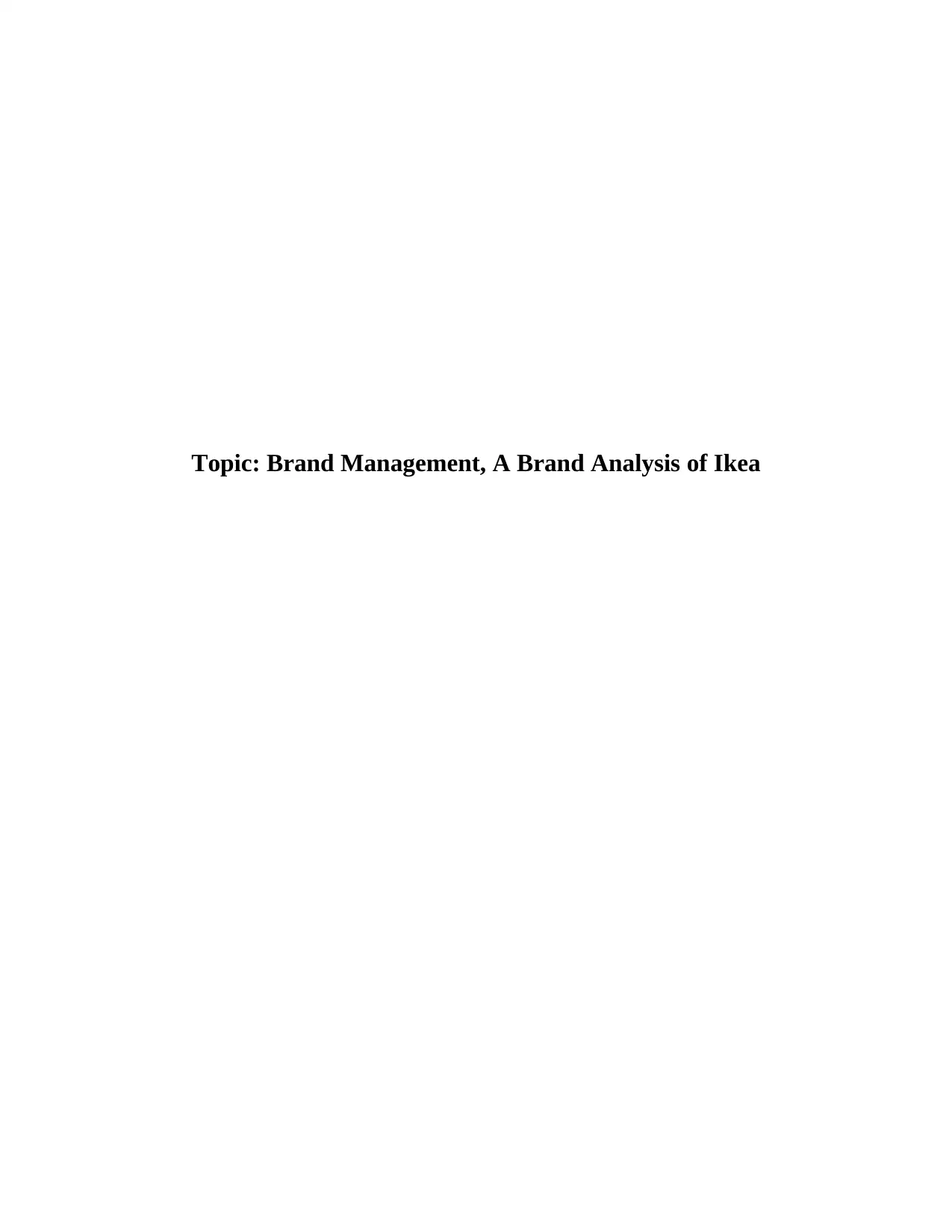
Topic: Brand Management, A Brand Analysis of Ikea
Paraphrase This Document
Need a fresh take? Get an instant paraphrase of this document with our AI Paraphraser
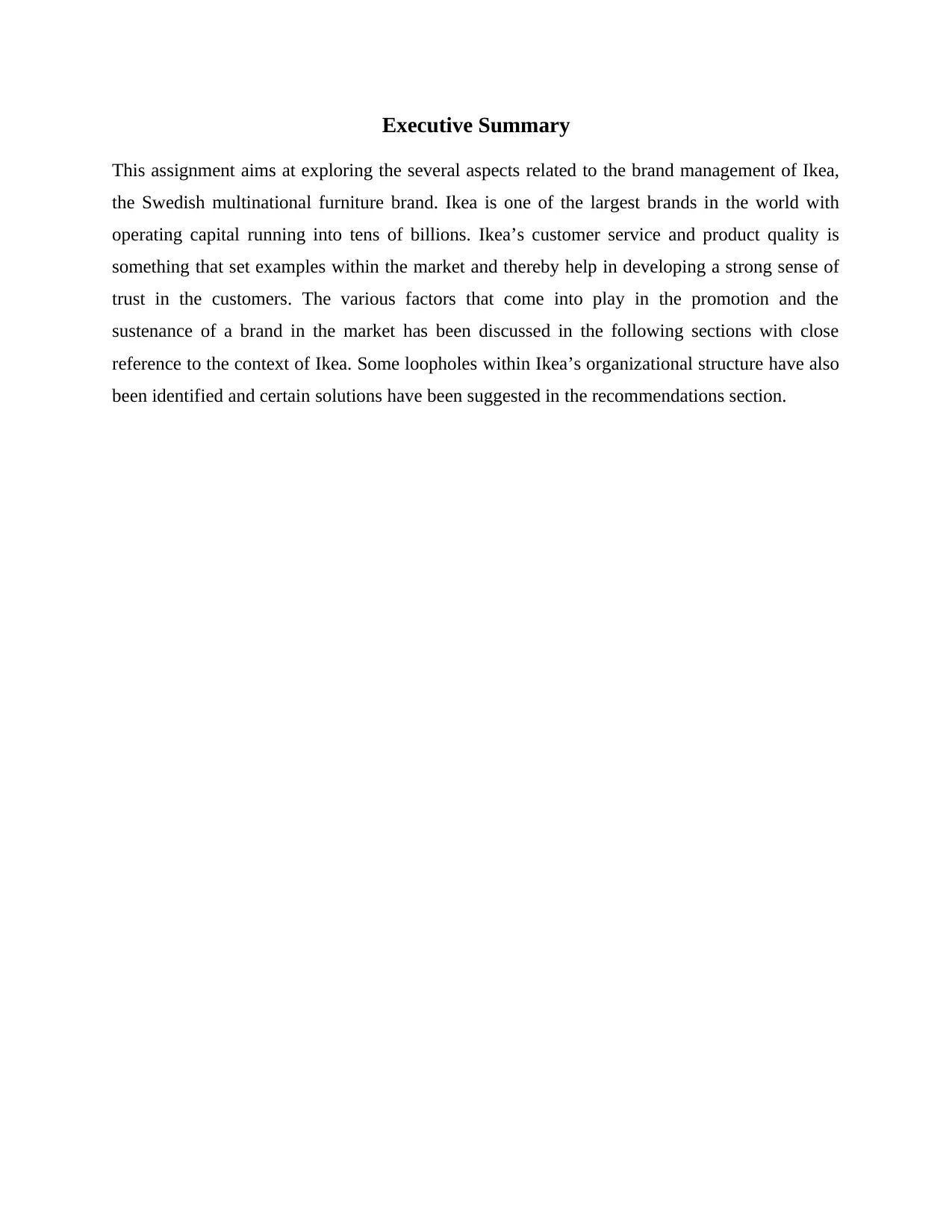
Executive Summary
This assignment aims at exploring the several aspects related to the brand management of Ikea,
the Swedish multinational furniture brand. Ikea is one of the largest brands in the world with
operating capital running into tens of billions. Ikea’s customer service and product quality is
something that set examples within the market and thereby help in developing a strong sense of
trust in the customers. The various factors that come into play in the promotion and the
sustenance of a brand in the market has been discussed in the following sections with close
reference to the context of Ikea. Some loopholes within Ikea’s organizational structure have also
been identified and certain solutions have been suggested in the recommendations section.
This assignment aims at exploring the several aspects related to the brand management of Ikea,
the Swedish multinational furniture brand. Ikea is one of the largest brands in the world with
operating capital running into tens of billions. Ikea’s customer service and product quality is
something that set examples within the market and thereby help in developing a strong sense of
trust in the customers. The various factors that come into play in the promotion and the
sustenance of a brand in the market has been discussed in the following sections with close
reference to the context of Ikea. Some loopholes within Ikea’s organizational structure have also
been identified and certain solutions have been suggested in the recommendations section.

Table of Contents
Introduction......................................................................................................................................4
Brand Inventory...............................................................................................................................4
Brand Identity..................................................................................................................................5
Brand Positioning............................................................................................................................5
Brand Elements................................................................................................................................6
Brand Communications...................................................................................................................6
Brand Architecture...........................................................................................................................7
Brand Exploratory...........................................................................................................................8
Brand Salience...............................................................................................................................11
Brand Imagery...............................................................................................................................12
Brand Performance(190)...............................................................................................................13
Figure 5: Brand performance: Ikea................................................................................................14
Brand Feeling(190)........................................................................................................................14
Brand Judgement...........................................................................................................................14
Brand Resonance...........................................................................................................................15
Recommendations..........................................................................................................................15
Conclusion.....................................................................................................................................15
References......................................................................................................................................17
Introduction......................................................................................................................................4
Brand Inventory...............................................................................................................................4
Brand Identity..................................................................................................................................5
Brand Positioning............................................................................................................................5
Brand Elements................................................................................................................................6
Brand Communications...................................................................................................................6
Brand Architecture...........................................................................................................................7
Brand Exploratory...........................................................................................................................8
Brand Salience...............................................................................................................................11
Brand Imagery...............................................................................................................................12
Brand Performance(190)...............................................................................................................13
Figure 5: Brand performance: Ikea................................................................................................14
Brand Feeling(190)........................................................................................................................14
Brand Judgement...........................................................................................................................14
Brand Resonance...........................................................................................................................15
Recommendations..........................................................................................................................15
Conclusion.....................................................................................................................................15
References......................................................................................................................................17
⊘ This is a preview!⊘
Do you want full access?
Subscribe today to unlock all pages.

Trusted by 1+ million students worldwide

Introduction
IKEA is a Swedish multinational corporation that is primarily known for manufacturing
furniture. However, when Ingvar Kamprad founded the organization, it used to manufacture
pens, wallets, jewelry and other everyday utility products. It was only five years later that Ikea
started selling furniture. The name Ikea was derived from the initials of Ingvar Kamprad and that
of the farm and village where he grew up respectively, Elmtaryd and Agunnaryd. Ikea is not only
known for its modernist and avant-garde designs of its furniture but also for the eco-friendly
methods it uses in manufacturing. The brand also engages in constant product development
which helps in reducing prices of the products over the years and also deliver better service to
customers (Khamis, 2016). Ikea was motivated by the idea that good products be made available
to buyers across all classes. The prevalent notion was that only rich people could afford to have
good furniture in their home but when Ikea emerged, it resolved to change that (Lewis, 2005).
Therefore, it can be inferred that apart from earning profits Ikea has a deeper commitment to the
market. It is needless to mention that this approach towards has been instrumental in promoting
Ikea as a brand internationally.
Brand Inventory
Ikea has one of the most advanced approaches towards inventory and supply chain management.
They integrate inventory management with their production processes so that they can get the
maximum efficiency out of their inventories. For example, they manufacture products in parts
which can be reassembled easily by the customer himself/herself. This not only helps in the
keeping of stocks but also substantially reduces transportation prices. Ikea also sees to it that it
maintains sustainable relationships with its suppliers so that it can get a steady flow of required
products. The communications and relationship management teams negotiate prices with
suppliers and also verify the quality of products (Grønholdtet al. 2015).
The stores are designed keeping in mind that it can house a large number of products that shall
appeal to the tastes of a wide range of customers. A warehouse is attached to the main showroom
floor where the products are stored which the customers shall choose from the showroom. And
since customers themselves can touch and choose the products they like, they can exercise full
IKEA is a Swedish multinational corporation that is primarily known for manufacturing
furniture. However, when Ingvar Kamprad founded the organization, it used to manufacture
pens, wallets, jewelry and other everyday utility products. It was only five years later that Ikea
started selling furniture. The name Ikea was derived from the initials of Ingvar Kamprad and that
of the farm and village where he grew up respectively, Elmtaryd and Agunnaryd. Ikea is not only
known for its modernist and avant-garde designs of its furniture but also for the eco-friendly
methods it uses in manufacturing. The brand also engages in constant product development
which helps in reducing prices of the products over the years and also deliver better service to
customers (Khamis, 2016). Ikea was motivated by the idea that good products be made available
to buyers across all classes. The prevalent notion was that only rich people could afford to have
good furniture in their home but when Ikea emerged, it resolved to change that (Lewis, 2005).
Therefore, it can be inferred that apart from earning profits Ikea has a deeper commitment to the
market. It is needless to mention that this approach towards has been instrumental in promoting
Ikea as a brand internationally.
Brand Inventory
Ikea has one of the most advanced approaches towards inventory and supply chain management.
They integrate inventory management with their production processes so that they can get the
maximum efficiency out of their inventories. For example, they manufacture products in parts
which can be reassembled easily by the customer himself/herself. This not only helps in the
keeping of stocks but also substantially reduces transportation prices. Ikea also sees to it that it
maintains sustainable relationships with its suppliers so that it can get a steady flow of required
products. The communications and relationship management teams negotiate prices with
suppliers and also verify the quality of products (Grønholdtet al. 2015).
The stores are designed keeping in mind that it can house a large number of products that shall
appeal to the tastes of a wide range of customers. A warehouse is attached to the main showroom
floor where the products are stored which the customers shall choose from the showroom. And
since customers themselves can touch and choose the products they like, they can exercise full
Paraphrase This Document
Need a fresh take? Get an instant paraphrase of this document with our AI Paraphraser
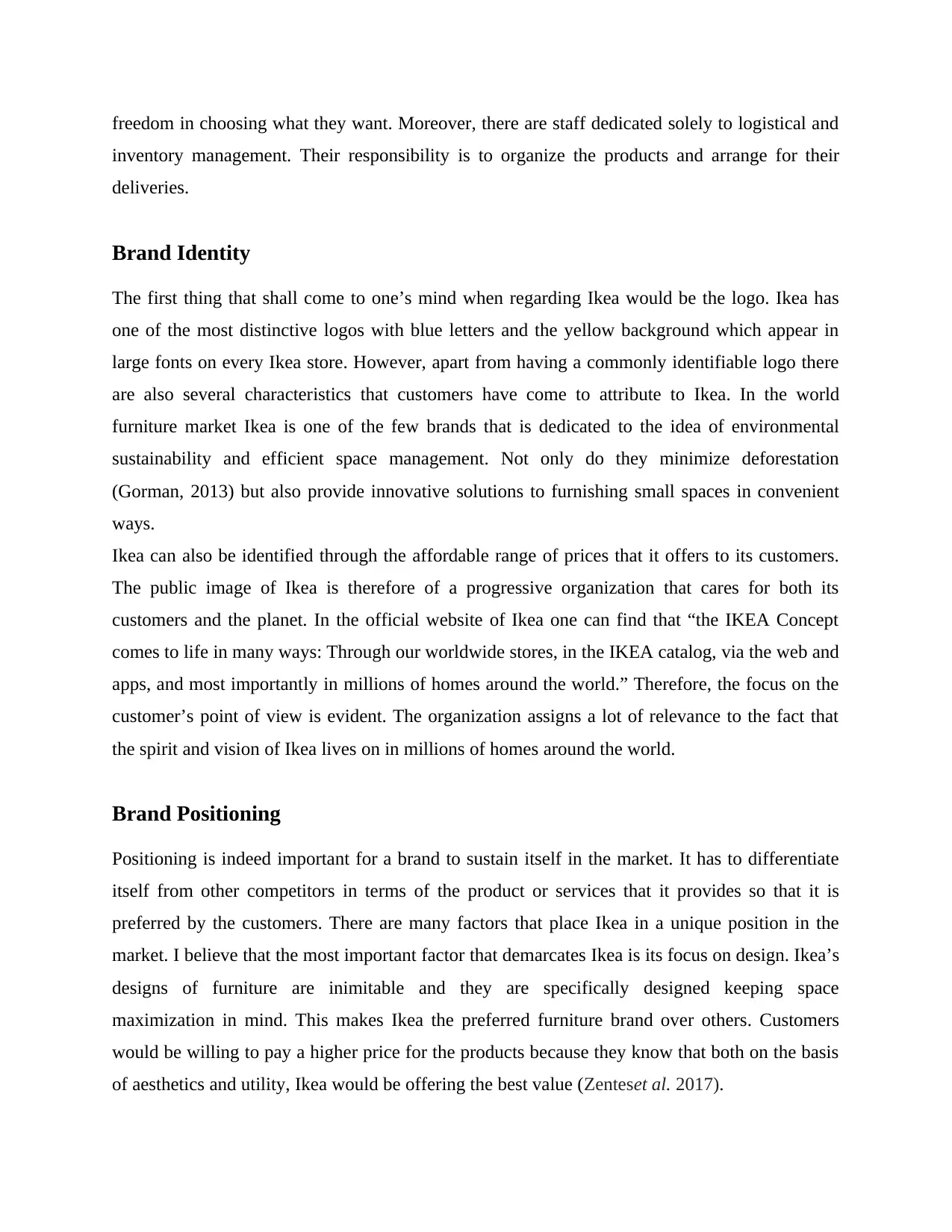
freedom in choosing what they want. Moreover, there are staff dedicated solely to logistical and
inventory management. Their responsibility is to organize the products and arrange for their
deliveries.
Brand Identity
The first thing that shall come to one’s mind when regarding Ikea would be the logo. Ikea has
one of the most distinctive logos with blue letters and the yellow background which appear in
large fonts on every Ikea store. However, apart from having a commonly identifiable logo there
are also several characteristics that customers have come to attribute to Ikea. In the world
furniture market Ikea is one of the few brands that is dedicated to the idea of environmental
sustainability and efficient space management. Not only do they minimize deforestation
(Gorman, 2013) but also provide innovative solutions to furnishing small spaces in convenient
ways.
Ikea can also be identified through the affordable range of prices that it offers to its customers.
The public image of Ikea is therefore of a progressive organization that cares for both its
customers and the planet. In the official website of Ikea one can find that “the IKEA Concept
comes to life in many ways: Through our worldwide stores, in the IKEA catalog, via the web and
apps, and most importantly in millions of homes around the world.” Therefore, the focus on the
customer’s point of view is evident. The organization assigns a lot of relevance to the fact that
the spirit and vision of Ikea lives on in millions of homes around the world.
Brand Positioning
Positioning is indeed important for a brand to sustain itself in the market. It has to differentiate
itself from other competitors in terms of the product or services that it provides so that it is
preferred by the customers. There are many factors that place Ikea in a unique position in the
market. I believe that the most important factor that demarcates Ikea is its focus on design. Ikea’s
designs of furniture are inimitable and they are specifically designed keeping space
maximization in mind. This makes Ikea the preferred furniture brand over others. Customers
would be willing to pay a higher price for the products because they know that both on the basis
of aesthetics and utility, Ikea would be offering the best value (Zenteset al. 2017).
inventory management. Their responsibility is to organize the products and arrange for their
deliveries.
Brand Identity
The first thing that shall come to one’s mind when regarding Ikea would be the logo. Ikea has
one of the most distinctive logos with blue letters and the yellow background which appear in
large fonts on every Ikea store. However, apart from having a commonly identifiable logo there
are also several characteristics that customers have come to attribute to Ikea. In the world
furniture market Ikea is one of the few brands that is dedicated to the idea of environmental
sustainability and efficient space management. Not only do they minimize deforestation
(Gorman, 2013) but also provide innovative solutions to furnishing small spaces in convenient
ways.
Ikea can also be identified through the affordable range of prices that it offers to its customers.
The public image of Ikea is therefore of a progressive organization that cares for both its
customers and the planet. In the official website of Ikea one can find that “the IKEA Concept
comes to life in many ways: Through our worldwide stores, in the IKEA catalog, via the web and
apps, and most importantly in millions of homes around the world.” Therefore, the focus on the
customer’s point of view is evident. The organization assigns a lot of relevance to the fact that
the spirit and vision of Ikea lives on in millions of homes around the world.
Brand Positioning
Positioning is indeed important for a brand to sustain itself in the market. It has to differentiate
itself from other competitors in terms of the product or services that it provides so that it is
preferred by the customers. There are many factors that place Ikea in a unique position in the
market. I believe that the most important factor that demarcates Ikea is its focus on design. Ikea’s
designs of furniture are inimitable and they are specifically designed keeping space
maximization in mind. This makes Ikea the preferred furniture brand over others. Customers
would be willing to pay a higher price for the products because they know that both on the basis
of aesthetics and utility, Ikea would be offering the best value (Zenteset al. 2017).
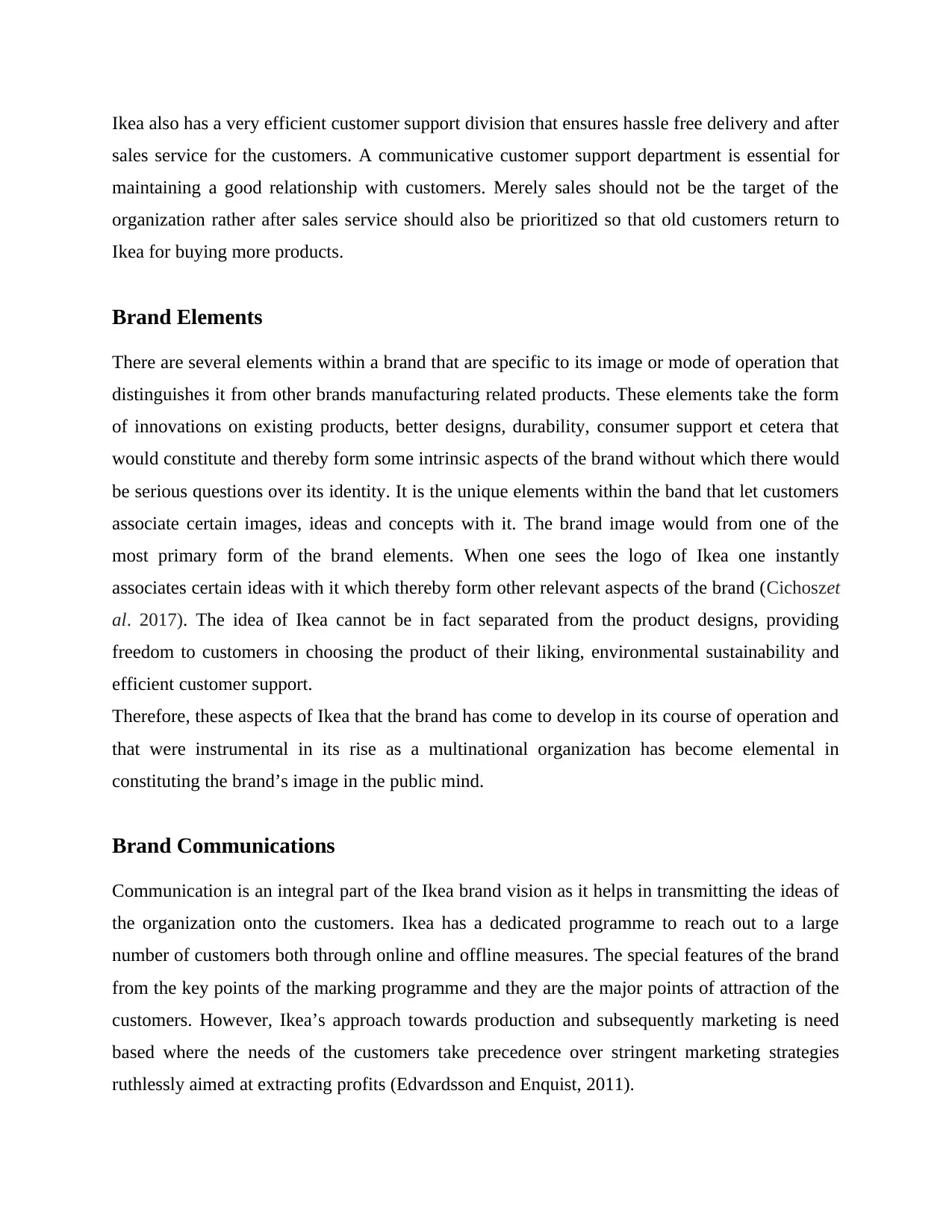
Ikea also has a very efficient customer support division that ensures hassle free delivery and after
sales service for the customers. A communicative customer support department is essential for
maintaining a good relationship with customers. Merely sales should not be the target of the
organization rather after sales service should also be prioritized so that old customers return to
Ikea for buying more products.
Brand Elements
There are several elements within a brand that are specific to its image or mode of operation that
distinguishes it from other brands manufacturing related products. These elements take the form
of innovations on existing products, better designs, durability, consumer support et cetera that
would constitute and thereby form some intrinsic aspects of the brand without which there would
be serious questions over its identity. It is the unique elements within the band that let customers
associate certain images, ideas and concepts with it. The brand image would from one of the
most primary form of the brand elements. When one sees the logo of Ikea one instantly
associates certain ideas with it which thereby form other relevant aspects of the brand (Cichoszet
al. 2017). The idea of Ikea cannot be in fact separated from the product designs, providing
freedom to customers in choosing the product of their liking, environmental sustainability and
efficient customer support.
Therefore, these aspects of Ikea that the brand has come to develop in its course of operation and
that were instrumental in its rise as a multinational organization has become elemental in
constituting the brand’s image in the public mind.
Brand Communications
Communication is an integral part of the Ikea brand vision as it helps in transmitting the ideas of
the organization onto the customers. Ikea has a dedicated programme to reach out to a large
number of customers both through online and offline measures. The special features of the brand
from the key points of the marking programme and they are the major points of attraction of the
customers. However, Ikea’s approach towards production and subsequently marketing is need
based where the needs of the customers take precedence over stringent marketing strategies
ruthlessly aimed at extracting profits (Edvardsson and Enquist, 2011).
sales service for the customers. A communicative customer support department is essential for
maintaining a good relationship with customers. Merely sales should not be the target of the
organization rather after sales service should also be prioritized so that old customers return to
Ikea for buying more products.
Brand Elements
There are several elements within a brand that are specific to its image or mode of operation that
distinguishes it from other brands manufacturing related products. These elements take the form
of innovations on existing products, better designs, durability, consumer support et cetera that
would constitute and thereby form some intrinsic aspects of the brand without which there would
be serious questions over its identity. It is the unique elements within the band that let customers
associate certain images, ideas and concepts with it. The brand image would from one of the
most primary form of the brand elements. When one sees the logo of Ikea one instantly
associates certain ideas with it which thereby form other relevant aspects of the brand (Cichoszet
al. 2017). The idea of Ikea cannot be in fact separated from the product designs, providing
freedom to customers in choosing the product of their liking, environmental sustainability and
efficient customer support.
Therefore, these aspects of Ikea that the brand has come to develop in its course of operation and
that were instrumental in its rise as a multinational organization has become elemental in
constituting the brand’s image in the public mind.
Brand Communications
Communication is an integral part of the Ikea brand vision as it helps in transmitting the ideas of
the organization onto the customers. Ikea has a dedicated programme to reach out to a large
number of customers both through online and offline measures. The special features of the brand
from the key points of the marking programme and they are the major points of attraction of the
customers. However, Ikea’s approach towards production and subsequently marketing is need
based where the needs of the customers take precedence over stringent marketing strategies
ruthlessly aimed at extracting profits (Edvardsson and Enquist, 2011).
⊘ This is a preview!⊘
Do you want full access?
Subscribe today to unlock all pages.

Trusted by 1+ million students worldwide
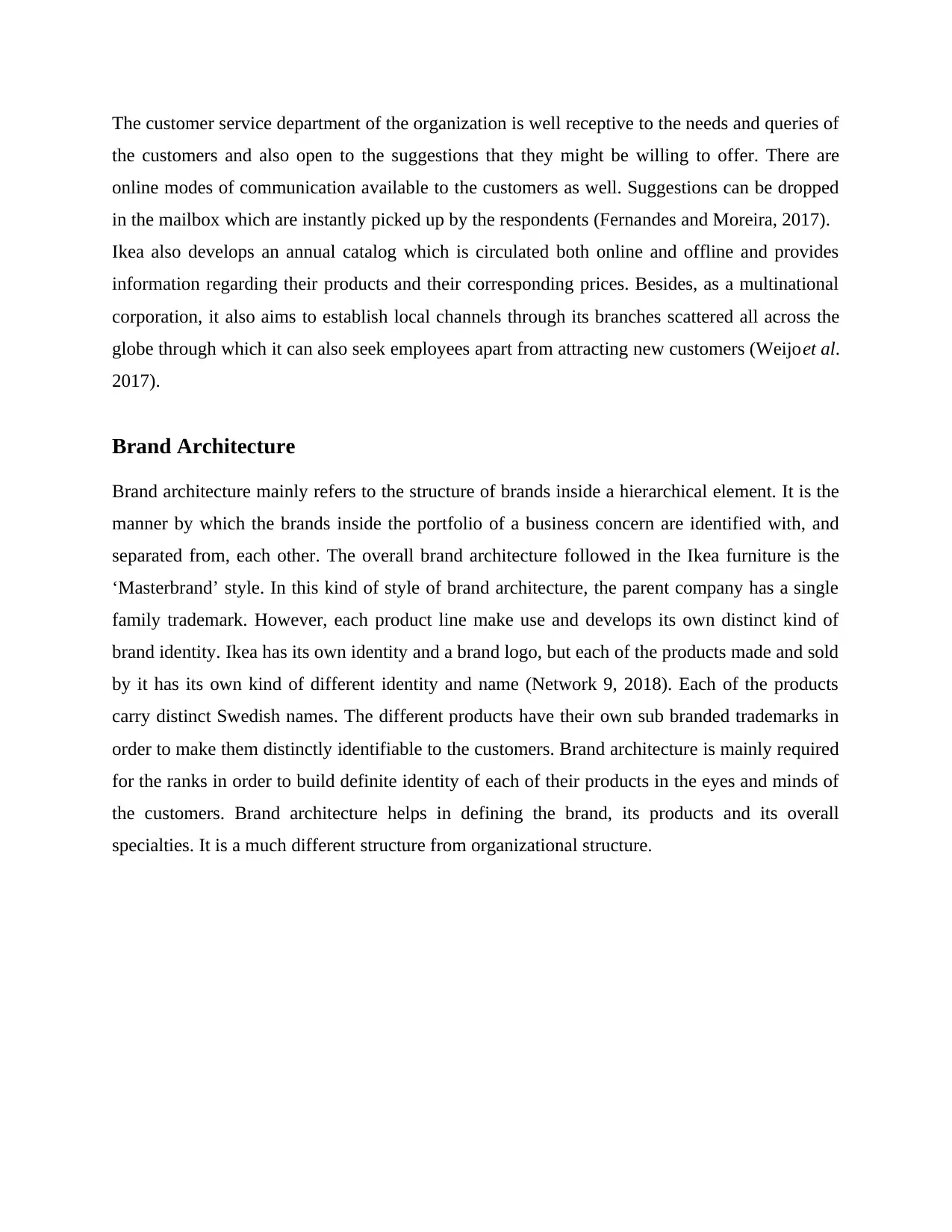
The customer service department of the organization is well receptive to the needs and queries of
the customers and also open to the suggestions that they might be willing to offer. There are
online modes of communication available to the customers as well. Suggestions can be dropped
in the mailbox which are instantly picked up by the respondents (Fernandes and Moreira, 2017).
Ikea also develops an annual catalog which is circulated both online and offline and provides
information regarding their products and their corresponding prices. Besides, as a multinational
corporation, it also aims to establish local channels through its branches scattered all across the
globe through which it can also seek employees apart from attracting new customers (Weijoet al.
2017).
Brand Architecture
Brand architecture mainly refers to the structure of brands inside a hierarchical element. It is the
manner by which the brands inside the portfolio of a business concern are identified with, and
separated from, each other. The overall brand architecture followed in the Ikea furniture is the
‘Masterbrand’ style. In this kind of style of brand architecture, the parent company has a single
family trademark. However, each product line make use and develops its own distinct kind of
brand identity. Ikea has its own identity and a brand logo, but each of the products made and sold
by it has its own kind of different identity and name (Network 9, 2018). Each of the products
carry distinct Swedish names. The different products have their own sub branded trademarks in
order to make them distinctly identifiable to the customers. Brand architecture is mainly required
for the ranks in order to build definite identity of each of their products in the eyes and minds of
the customers. Brand architecture helps in defining the brand, its products and its overall
specialties. It is a much different structure from organizational structure.
the customers and also open to the suggestions that they might be willing to offer. There are
online modes of communication available to the customers as well. Suggestions can be dropped
in the mailbox which are instantly picked up by the respondents (Fernandes and Moreira, 2017).
Ikea also develops an annual catalog which is circulated both online and offline and provides
information regarding their products and their corresponding prices. Besides, as a multinational
corporation, it also aims to establish local channels through its branches scattered all across the
globe through which it can also seek employees apart from attracting new customers (Weijoet al.
2017).
Brand Architecture
Brand architecture mainly refers to the structure of brands inside a hierarchical element. It is the
manner by which the brands inside the portfolio of a business concern are identified with, and
separated from, each other. The overall brand architecture followed in the Ikea furniture is the
‘Masterbrand’ style. In this kind of style of brand architecture, the parent company has a single
family trademark. However, each product line make use and develops its own distinct kind of
brand identity. Ikea has its own identity and a brand logo, but each of the products made and sold
by it has its own kind of different identity and name (Network 9, 2018). Each of the products
carry distinct Swedish names. The different products have their own sub branded trademarks in
order to make them distinctly identifiable to the customers. Brand architecture is mainly required
for the ranks in order to build definite identity of each of their products in the eyes and minds of
the customers. Brand architecture helps in defining the brand, its products and its overall
specialties. It is a much different structure from organizational structure.
Paraphrase This Document
Need a fresh take? Get an instant paraphrase of this document with our AI Paraphraser
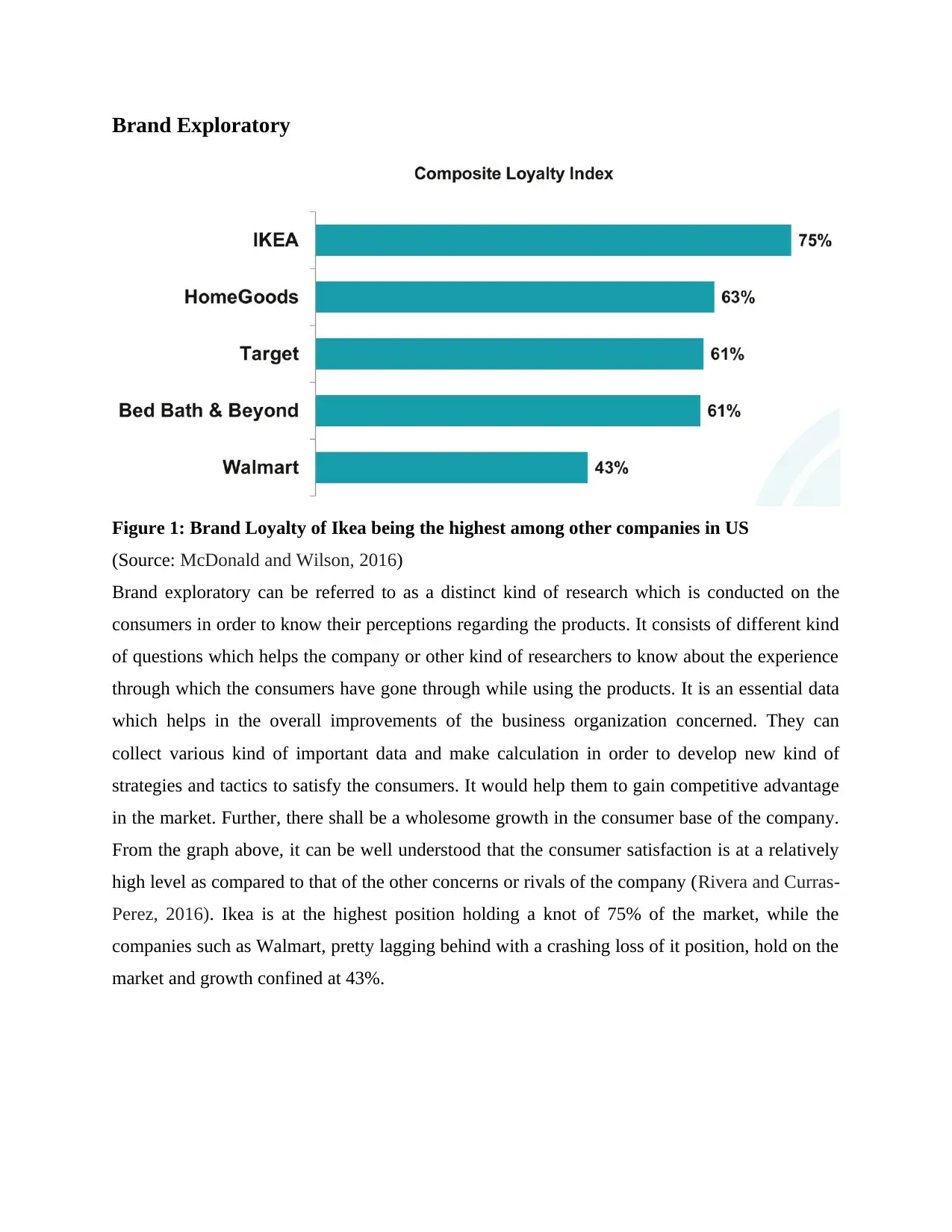
Brand Exploratory
Figure 1: Brand Loyalty of Ikea being the highest among other companies in US
(Source: McDonald and Wilson, 2016)
Brand exploratory can be referred to as a distinct kind of research which is conducted on the
consumers in order to know their perceptions regarding the products. It consists of different kind
of questions which helps the company or other kind of researchers to know about the experience
through which the consumers have gone through while using the products. It is an essential data
which helps in the overall improvements of the business organization concerned. They can
collect various kind of important data and make calculation in order to develop new kind of
strategies and tactics to satisfy the consumers. It would help them to gain competitive advantage
in the market. Further, there shall be a wholesome growth in the consumer base of the company.
From the graph above, it can be well understood that the consumer satisfaction is at a relatively
high level as compared to that of the other concerns or rivals of the company (Rivera and Curras-
Perez, 2016). Ikea is at the highest position holding a knot of 75% of the market, while the
companies such as Walmart, pretty lagging behind with a crashing loss of it position, hold on the
market and growth confined at 43%.
Figure 1: Brand Loyalty of Ikea being the highest among other companies in US
(Source: McDonald and Wilson, 2016)
Brand exploratory can be referred to as a distinct kind of research which is conducted on the
consumers in order to know their perceptions regarding the products. It consists of different kind
of questions which helps the company or other kind of researchers to know about the experience
through which the consumers have gone through while using the products. It is an essential data
which helps in the overall improvements of the business organization concerned. They can
collect various kind of important data and make calculation in order to develop new kind of
strategies and tactics to satisfy the consumers. It would help them to gain competitive advantage
in the market. Further, there shall be a wholesome growth in the consumer base of the company.
From the graph above, it can be well understood that the consumer satisfaction is at a relatively
high level as compared to that of the other concerns or rivals of the company (Rivera and Curras-
Perez, 2016). Ikea is at the highest position holding a knot of 75% of the market, while the
companies such as Walmart, pretty lagging behind with a crashing loss of it position, hold on the
market and growth confined at 43%.
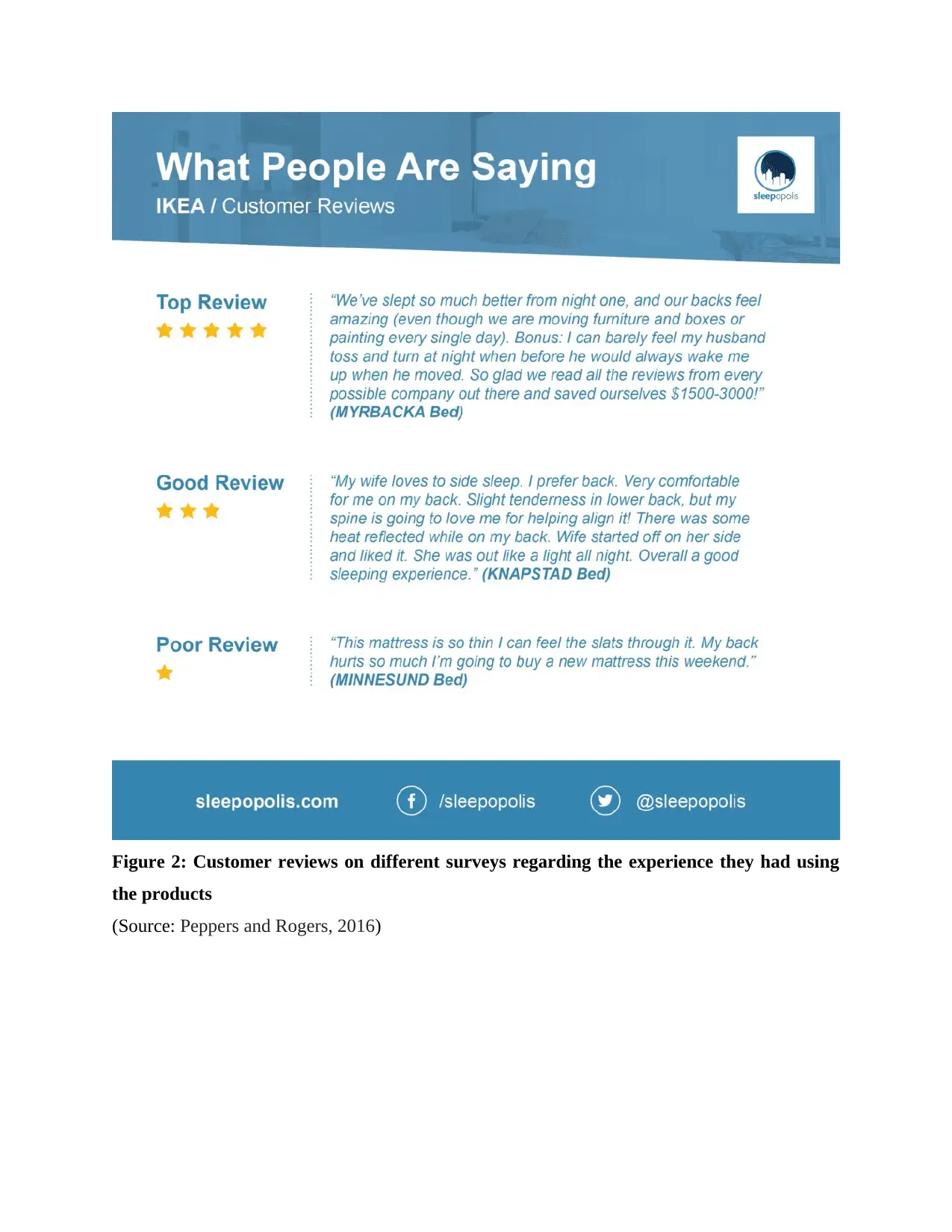
Figure 2: Customer reviews on different surveys regarding the experience they had using
the products
(Source: Peppers and Rogers, 2016)
the products
(Source: Peppers and Rogers, 2016)
⊘ This is a preview!⊘
Do you want full access?
Subscribe today to unlock all pages.

Trusted by 1+ million students worldwide
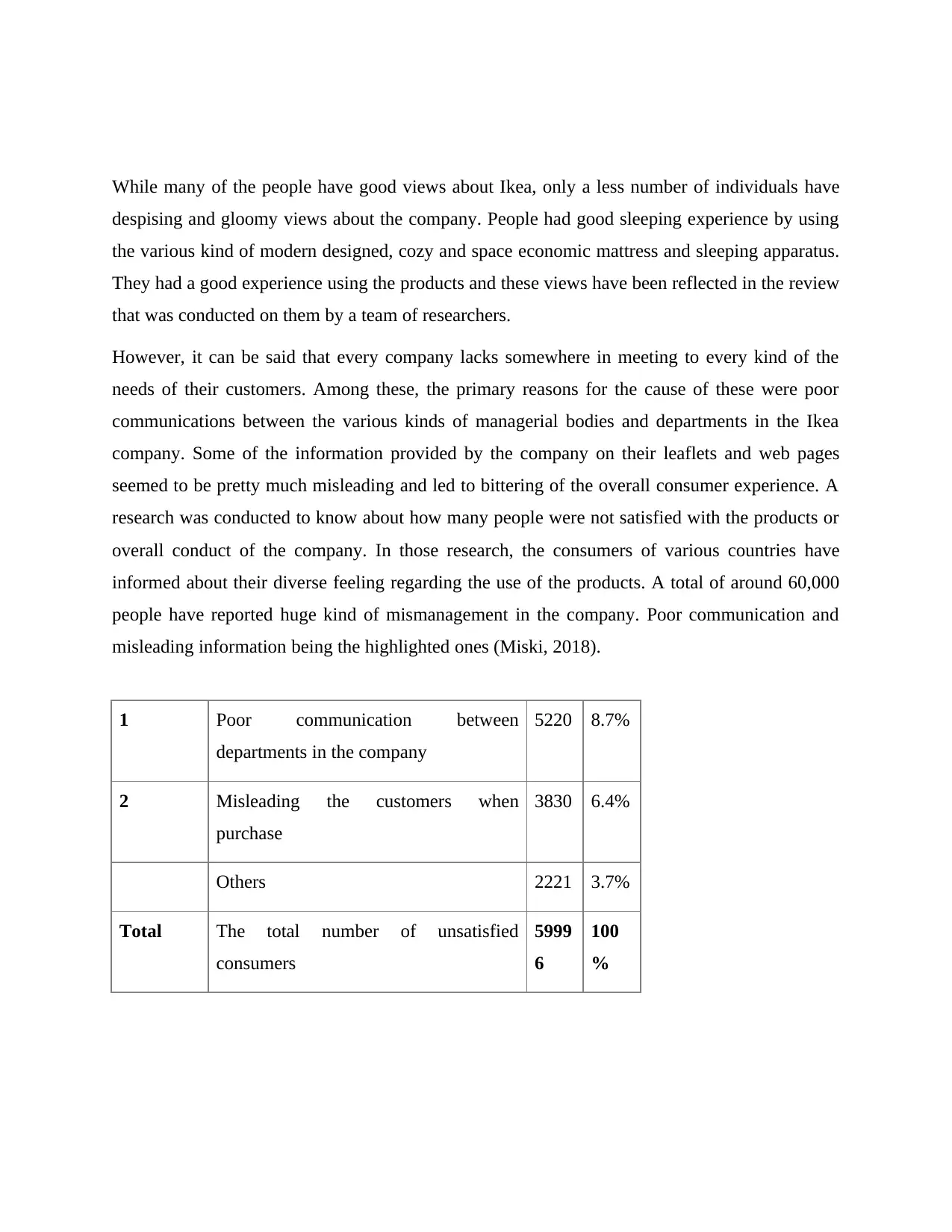
While many of the people have good views about Ikea, only a less number of individuals have
despising and gloomy views about the company. People had good sleeping experience by using
the various kind of modern designed, cozy and space economic mattress and sleeping apparatus.
They had a good experience using the products and these views have been reflected in the review
that was conducted on them by a team of researchers.
However, it can be said that every company lacks somewhere in meeting to every kind of the
needs of their customers. Among these, the primary reasons for the cause of these were poor
communications between the various kinds of managerial bodies and departments in the Ikea
company. Some of the information provided by the company on their leaflets and web pages
seemed to be pretty much misleading and led to bittering of the overall consumer experience. A
research was conducted to know about how many people were not satisfied with the products or
overall conduct of the company. In those research, the consumers of various countries have
informed about their diverse feeling regarding the use of the products. A total of around 60,000
people have reported huge kind of mismanagement in the company. Poor communication and
misleading information being the highlighted ones (Miski, 2018).
1 Poor communication between
departments in the company
5220 8.7%
2 Misleading the customers when
purchase
3830 6.4%
Others 2221 3.7%
Total The total number of unsatisfied
consumers
5999
6
100
%
despising and gloomy views about the company. People had good sleeping experience by using
the various kind of modern designed, cozy and space economic mattress and sleeping apparatus.
They had a good experience using the products and these views have been reflected in the review
that was conducted on them by a team of researchers.
However, it can be said that every company lacks somewhere in meeting to every kind of the
needs of their customers. Among these, the primary reasons for the cause of these were poor
communications between the various kinds of managerial bodies and departments in the Ikea
company. Some of the information provided by the company on their leaflets and web pages
seemed to be pretty much misleading and led to bittering of the overall consumer experience. A
research was conducted to know about how many people were not satisfied with the products or
overall conduct of the company. In those research, the consumers of various countries have
informed about their diverse feeling regarding the use of the products. A total of around 60,000
people have reported huge kind of mismanagement in the company. Poor communication and
misleading information being the highlighted ones (Miski, 2018).
1 Poor communication between
departments in the company
5220 8.7%
2 Misleading the customers when
purchase
3830 6.4%
Others 2221 3.7%
Total The total number of unsatisfied
consumers
5999
6
100
%
Paraphrase This Document
Need a fresh take? Get an instant paraphrase of this document with our AI Paraphraser
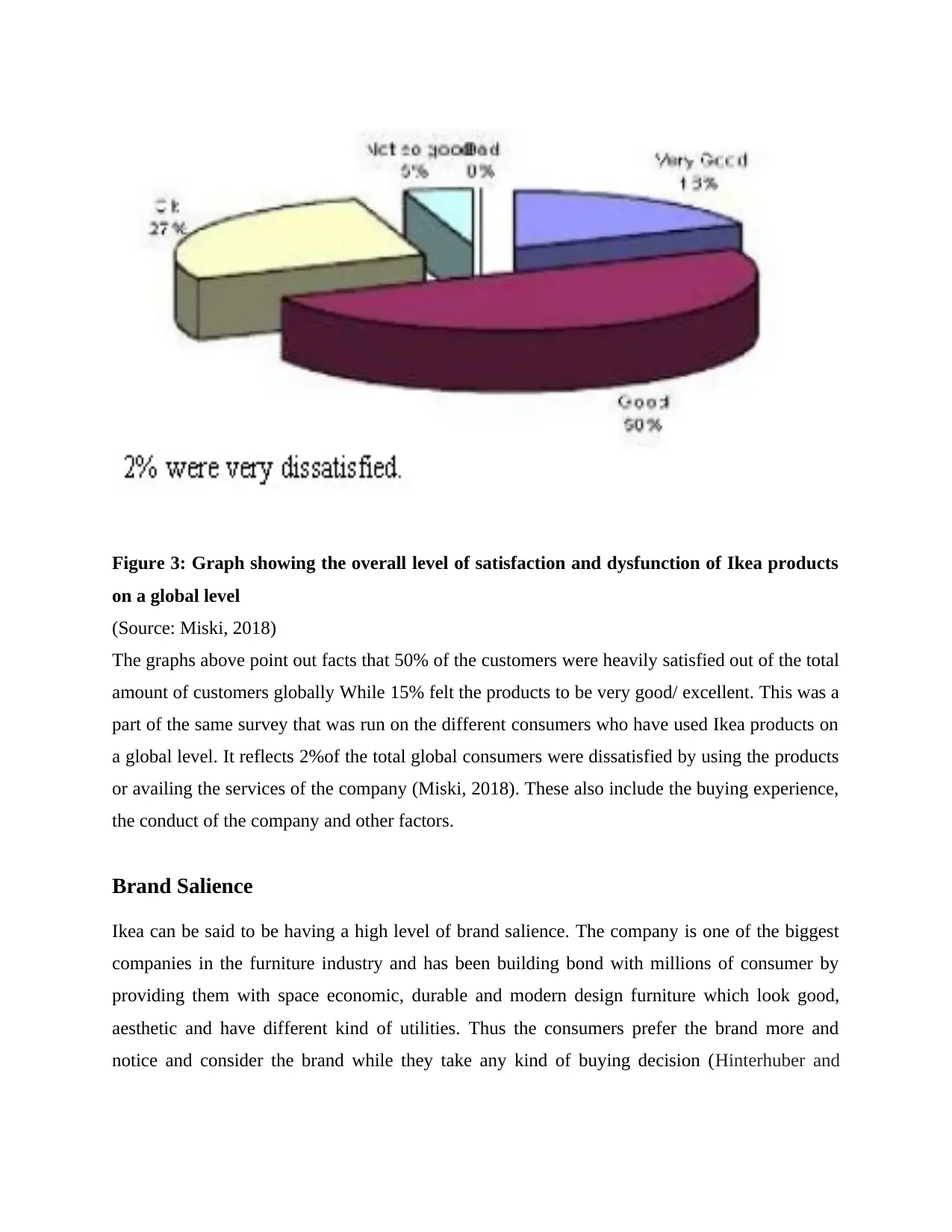
Figure 3: Graph showing the overall level of satisfaction and dysfunction of Ikea products
on a global level
(Source: Miski, 2018)
The graphs above point out facts that 50% of the customers were heavily satisfied out of the total
amount of customers globally While 15% felt the products to be very good/ excellent. This was a
part of the same survey that was run on the different consumers who have used Ikea products on
a global level. It reflects 2%of the total global consumers were dissatisfied by using the products
or availing the services of the company (Miski, 2018). These also include the buying experience,
the conduct of the company and other factors.
Brand Salience
Ikea can be said to be having a high level of brand salience. The company is one of the biggest
companies in the furniture industry and has been building bond with millions of consumer by
providing them with space economic, durable and modern design furniture which look good,
aesthetic and have different kind of utilities. Thus the consumers prefer the brand more and
notice and consider the brand while they take any kind of buying decision (Hinterhuber and
on a global level
(Source: Miski, 2018)
The graphs above point out facts that 50% of the customers were heavily satisfied out of the total
amount of customers globally While 15% felt the products to be very good/ excellent. This was a
part of the same survey that was run on the different consumers who have used Ikea products on
a global level. It reflects 2%of the total global consumers were dissatisfied by using the products
or availing the services of the company (Miski, 2018). These also include the buying experience,
the conduct of the company and other factors.
Brand Salience
Ikea can be said to be having a high level of brand salience. The company is one of the biggest
companies in the furniture industry and has been building bond with millions of consumer by
providing them with space economic, durable and modern design furniture which look good,
aesthetic and have different kind of utilities. Thus the consumers prefer the brand more and
notice and consider the brand while they take any kind of buying decision (Hinterhuber and
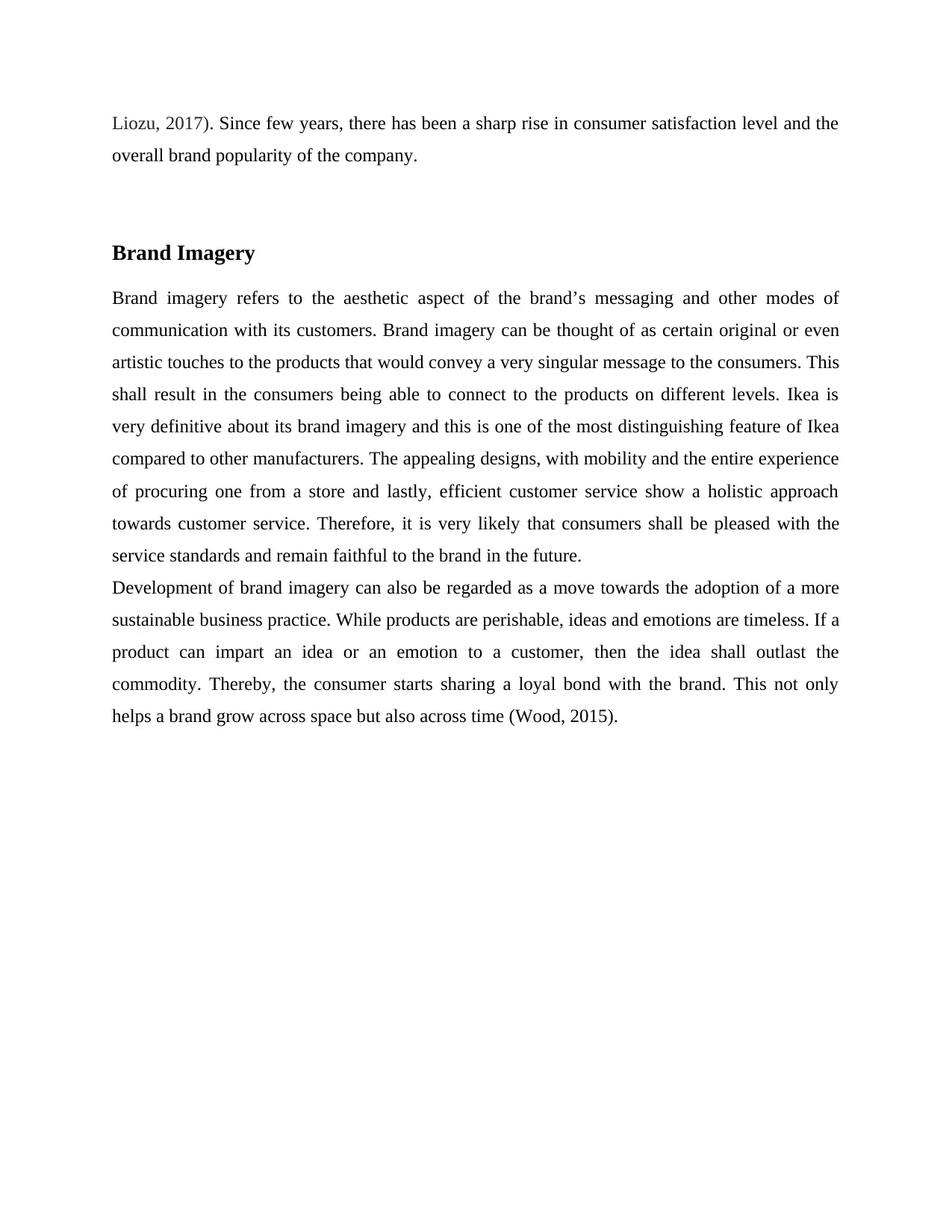
Liozu, 2017). Since few years, there has been a sharp rise in consumer satisfaction level and the
overall brand popularity of the company.
Brand Imagery
Brand imagery refers to the aesthetic aspect of the brand’s messaging and other modes of
communication with its customers. Brand imagery can be thought of as certain original or even
artistic touches to the products that would convey a very singular message to the consumers. This
shall result in the consumers being able to connect to the products on different levels. Ikea is
very definitive about its brand imagery and this is one of the most distinguishing feature of Ikea
compared to other manufacturers. The appealing designs, with mobility and the entire experience
of procuring one from a store and lastly, efficient customer service show a holistic approach
towards customer service. Therefore, it is very likely that consumers shall be pleased with the
service standards and remain faithful to the brand in the future.
Development of brand imagery can also be regarded as a move towards the adoption of a more
sustainable business practice. While products are perishable, ideas and emotions are timeless. If a
product can impart an idea or an emotion to a customer, then the idea shall outlast the
commodity. Thereby, the consumer starts sharing a loyal bond with the brand. This not only
helps a brand grow across space but also across time (Wood, 2015).
overall brand popularity of the company.
Brand Imagery
Brand imagery refers to the aesthetic aspect of the brand’s messaging and other modes of
communication with its customers. Brand imagery can be thought of as certain original or even
artistic touches to the products that would convey a very singular message to the consumers. This
shall result in the consumers being able to connect to the products on different levels. Ikea is
very definitive about its brand imagery and this is one of the most distinguishing feature of Ikea
compared to other manufacturers. The appealing designs, with mobility and the entire experience
of procuring one from a store and lastly, efficient customer service show a holistic approach
towards customer service. Therefore, it is very likely that consumers shall be pleased with the
service standards and remain faithful to the brand in the future.
Development of brand imagery can also be regarded as a move towards the adoption of a more
sustainable business practice. While products are perishable, ideas and emotions are timeless. If a
product can impart an idea or an emotion to a customer, then the idea shall outlast the
commodity. Thereby, the consumer starts sharing a loyal bond with the brand. This not only
helps a brand grow across space but also across time (Wood, 2015).
⊘ This is a preview!⊘
Do you want full access?
Subscribe today to unlock all pages.

Trusted by 1+ million students worldwide
1 out of 19
Related Documents
Your All-in-One AI-Powered Toolkit for Academic Success.
+13062052269
info@desklib.com
Available 24*7 on WhatsApp / Email
![[object Object]](/_next/static/media/star-bottom.7253800d.svg)
Unlock your academic potential
Copyright © 2020–2025 A2Z Services. All Rights Reserved. Developed and managed by ZUCOL.




